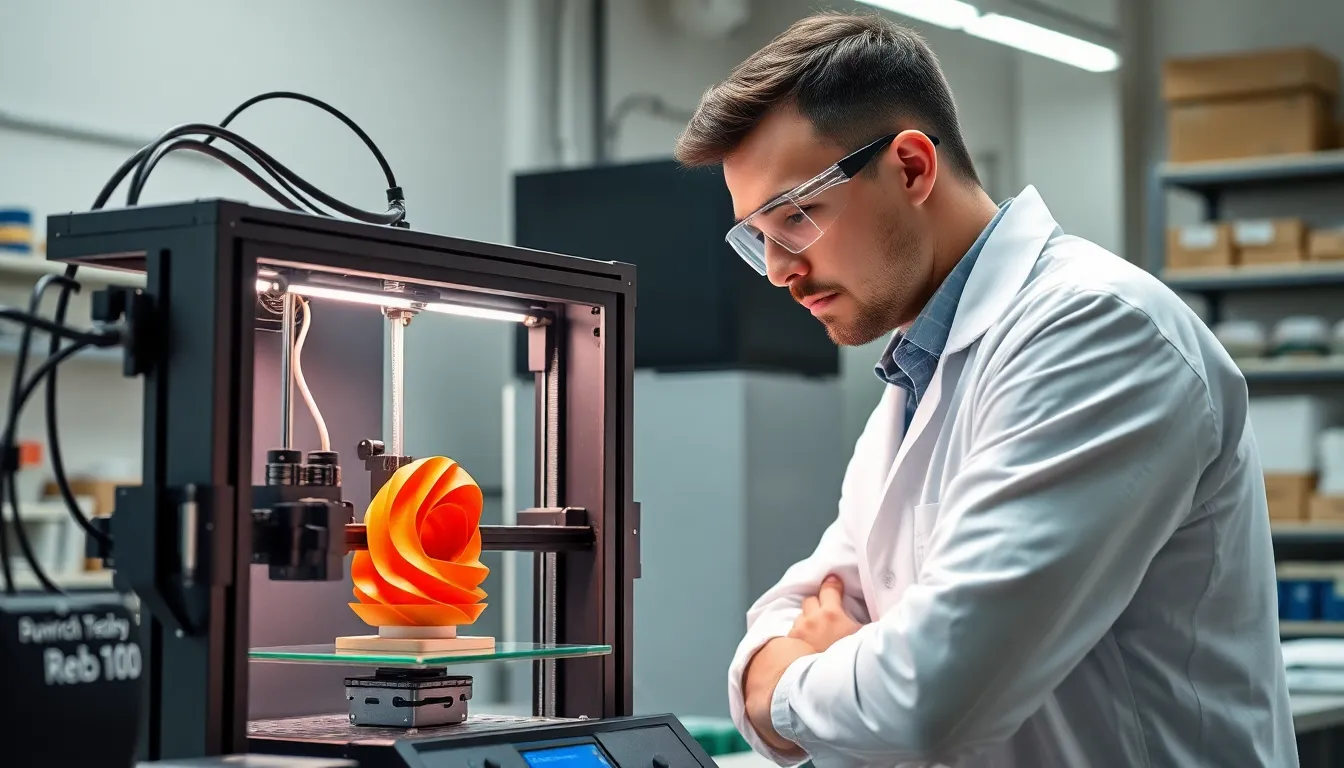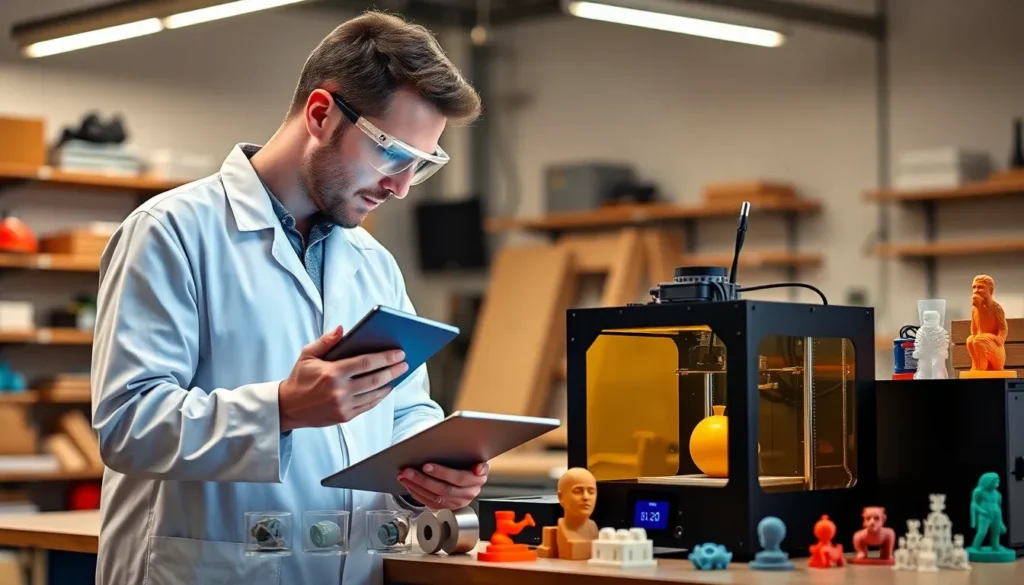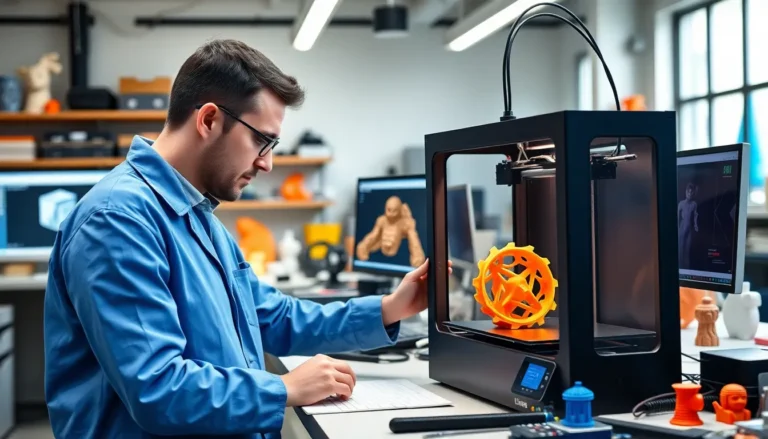Table of Contents
ToggleIn a world where imagination meets innovation, 3D printing engineers are the wizards turning dreams into reality—without the need for a magic wand. These tech-savvy professionals harness the power of additive manufacturing to create everything from intricate prototypes to life-saving medical devices. If you’ve ever wished for a personal genie to grant your design wishes, look no further than the 3D printing engineer.
Overview of 3D Printing Engineering
3D printing engineers play a vital role in the field of additive manufacturing. They combine design, technology, and material science to develop innovative products.
Definition of a 3D Printing Engineer
A 3D printing engineer designs and creates objects using 3D printing technology. This professional transforms digital models into physical items through various additive processes. They select appropriate materials and techniques for each project, ensuring quality and functionality. Focus on precision is essential, as engineers must account for tolerances and intricacies of different applications. Familiarity with software, hardware, and industrial practices characterizes their expertise. Creativity and problem-solving skills distinguish these engineers in their efforts to meet diverse customer needs.
Importance in Modern Manufacturing
In modern manufacturing, 3D printing engineers significantly enhance production efficiency. They enable rapid prototyping, which accelerates the design cycle for products. Customization capabilities allow manufacturers to tailor products for specific market demands without extensive costs. Improved material utilization is another advantage, leading to reduced waste and lower overall expenses. Engineers facilitate complex geometries that traditional methods cannot achieve, opening new possibilities across industries. Their contributions make it possible for businesses to innovate faster, adapt to trends, and make informed decisions.
Skills Required for a 3D Printing Engineer

3D printing engineers possess a unique blend of skills essential for their role in the rapidly evolving field of additive manufacturing.
Technical Skills
Expertise in CAD software stands at the forefront of a 3D printing engineer’s technical skills. Familiarity with programs such as SolidWorks or AutoCAD enables them to create and modify complex designs. Understanding various 3D printing processes, including FDM and SLA, is critical for selecting the right method for each project. Knowledge of materials, from thermoplastics to metals, ensures that the finished product meets specifications. Additionally, troubleshooting skills help engineers resolve issues that may arise during the printing process. Staying updated on the latest advancements in 3D printing technology enhances their ability to innovate and improve existing processes.
Soft Skills
Strong problem-solving abilities define a successful 3D printing engineer. They often face unexpected challenges that require quick thinking and creativity. Effective communication skills foster collaboration with team members, ensuring that design expectations align with production capabilities. Adaptability is also vital, as technologies and materials continue to evolve. Attention to detail plays a crucial role in maintaining high-quality standards throughout the design and printing stages. Furthermore, project management skills help engineers meet deadlines while balancing multiple tasks. These soft skills complement technical expertise, creating a well-rounded professional ready to tackle diverse projects.
Career Path and Opportunities
3D printing engineers face various career avenues that require strong educational foundations and diverse skill sets. Opportunities abound across multiple industries, showcasing the growing importance of additive manufacturing.
Educational Requirements
A bachelor’s degree in fields like engineering, industrial design, or material science serves as a standard entry point. Many employers prefer candidates with specialized training in 3D printing technology or additive manufacturing. Additional certifications in CAD software or specific 3D printing processes enhance employability. Advanced degrees improve prospects for roles in research or leadership positions. Continuous professional development through workshops or online courses keeps engineers updated on trends and innovations.
Job Opportunities and Industries
Industries ranging from aerospace to healthcare actively seek 3D printing engineers. In aerospace, professionals create lightweight components to improve fuel efficiency. The automotive sector employs engineers to innovate custom parts and prototypes. Medical fields benefit from engineers designing personalized implants and prosthetics. Consumer products industries harness 3D printing for rapid prototyping of new products. Each sector values the abilities of 3D printing engineers to reduce costs and enhance design flexibilities.
Challenges Faced by 3D Printing Engineers
3D printing engineers encounter various challenges in their field, impacting their ability to innovate and produce. Technical hurdles and ethical considerations stand out as primary concerns.
Technical Challenges
Complexities in print quality and precision arise often. Engineers frequently contend with issues such as material compatibility, which can affect the final product’s durability and performance. The limitations of current 3D printing technologies also complicate achieving desired specifications. Engineers rely on rigorous testing to fine-tune processes and prevent failures. Inconsistent material properties may result in defects, necessitating constant adjustments. Engineers assess emerging technologies to stay competitive and tackle long-standing challenges.
Ethical Considerations
Ethical dilemmas also surface in the realm of 3D printing. Intellectual property concerns emerge as designers replicate existing products, raising questions about originality. Safety becomes another critical issue, especially when producing medical devices or components for aerospace. Engineers must ensure compliance with regulatory standards to protect consumers. Addressing environmental impacts of materials used in 3D printing is essential for sustainability. Engineers strive to balance innovation and responsibility while navigating these ethical challenges successfully.
Future of 3D Printing Engineering
3D printing engineering is evolving rapidly, driven by technological advancements and industry demand. Emerging tools and processes are transforming the landscape of additive manufacturing, presenting new opportunities for innovation.
Emerging Technologies
New technologies significantly reshape the 3D printing field, making operations more efficient and precise. Advanced materials, including bio-based and composite options, enhance product performance and sustainability. Machine learning algorithms contribute to optimized design processes, allowing engineers to create more complex and tailored products. Novel printing methods, like multi-material and hybrid printing, expand functionality and application versatility. Robotics integration improves automation, reducing production time while increasing accuracy. Engineers must stay abreast of these technologies to leverage their full potential and drive industry advancement.
Potential Impact on Various Sectors
3D printing’s impact spans multiple sectors, revolutionizing traditional manufacturing processes. The aerospace industry benefits from lightweight components, reducing fuel consumption and overall costs. Healthcare sees personalized medical devices tailored to individual needs, ultimately improving patient outcomes. The automotive sector enhances design flexibility with rapid prototyping, allowing for custom parts and faster market entry. Consumer products gain from unique designs previously unattainable with conventional manufacturing. As growth continues, 3D printing engineering will play a crucial role in shaping the future landscape across diverse industries.
The role of a 3D printing engineer is crucial in today’s manufacturing landscape. These professionals bridge the gap between creativity and technology, driving innovation across various industries. With their unique skill set they can tackle challenges and deliver customized solutions that meet evolving market demands.
As the industry continues to grow and adapt to new technologies the opportunities for 3D printing engineers are expanding. Their ability to create complex designs while ensuring quality and efficiency positions them as key players in shaping the future of manufacturing. Embracing continuous learning and staying abreast of advancements will empower these engineers to lead the way in this dynamic field.





